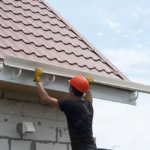Every homeowner may find themselves faced with the need to reshingle a roof at some point. Understanding the process can save you money and extend the life of your roof. In this comprehensive guide, we’ll explore the steps involved in reshingle a roof, ensuring you’re well-prepared for this home improvement task.

Understanding When to Reshingle Your Roof
Knowing when to reshingle your roof is crucial. Signs such as missing, curling, or cracked shingles are clear indicators. If you’re noticing leakage or increased energy bills, it might be time to consider a reshingle.
Planning Your Roofing Project
Proper planning is key. Evaluate the current state of your roof and decide whether you’ll do it yourself or hire a professional. For more on choosing the right contractor, visit this guide.
Choosing the Right Shingles
Selecting the proper shingles is vital for longevity and aesthetics. Consider materials like asphalt, wood, or metal. Each has its benefits; make an informed choice based on your home’s needs.
Preparing for the Reshingle
Proper preparation makes the job smoother. Gather necessary tools, inspect your roof, and set up safety measures before starting. A well-prepared site ensures effectiveness.
Tools and Safety Gear
You will need common tools like a hammer, roofing nails, and a utility knife. Safety gear such as gloves, a hard hat, and sturdy shoes is also essential to prevent accidents.
Step-by-Step Guide to Reshingling
1. Removing Old Shingles
Start by stripping away old shingles and disposing of them properly. Use a pry bar to loosen nails and carefully remove the shingles to avoid damaging the roof deck.
2. Inspecting the Roof Deck
After removal, inspect the deck for damage. Rotten or weak areas need repair before new shingles are applied. It’s critical to maintain a solid base for your new shingles.
3. Installing Underlayment
Underlayment is a protective layer that sits between your shingles and the roof structure. Install this carefully, ensuring there are no gaps or overlapping sections.
4. Laying New Shingles
Start laying new shingles from the bottom edge, working upwards. Overlapping each row properly ensures water runs off efficiently. Use nails to secure them in place, maintaining uniform alignment.
Post-Project Inspection
After reshingle, inspect your new roof. Check for alignment issues, secure nails, and ensure flashings are in place. This final check helps prevent future issues.
Maintenance Tips for a Long-Lasting Roof
Regular maintenance increases your roof’s lifespan. Inspect it twice a year for damage, remove debris, and clean gutters. This proactive approach reduces future problems.
Dealing with Weather Damage
Weather can severely affect your roof. After a storm, check for missing shingles or leaks. Quick repairs prevent minor issues from becoming major repairs.
Costs and Budgeting Tips
Budgeting for a reshingle project involves considering material and labor costs. To get a sense of what you might expect, visit this external resource for detailed pricing.
Financing Your Project
Research financing options if budget is a concern. Many providers offer reasonable payment plans for roofing projects, making it manageable for various budgets.
Environmental Considerations
Choose eco-friendly shingles and dispose of old ones responsibly. This environmentally conscious choice benefits both your home and the planet.
Energy Efficiency
Opt for reflective shingles to reduce heat absorption and lower your energy bills. This small investment can save you money in the long run.
Final Thoughts on Reshingle Projects
Undertaking a reshingle project is significant but highly rewarding. Armed with the knowledge from this guide, you’re ready to start. For further roofing insights, explore information about EPDM roofing.

FAQ
What is the lifespan of new shingles?
New shingles typically last between 20-30 years, depending on the material and maintenance.
Can I reshingle a roof myself?
Yes, it’s possible with the right tools and safety precautions. However, hiring a professional is recommended for those lacking experience.
How do I choose the right shingle color?
Consider the style of your home and environmental factors. A roofing specialist can provide personalized suggestions.
This article contains affiliate links. We may earn a commission at no extra cost to you.








